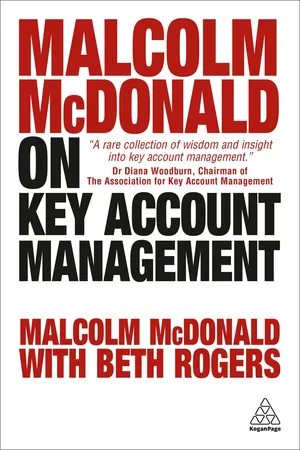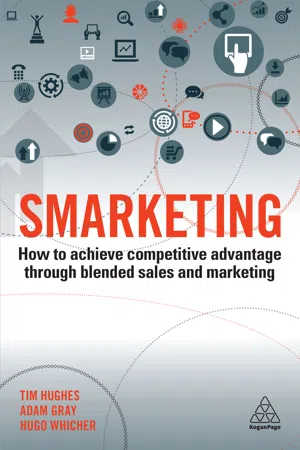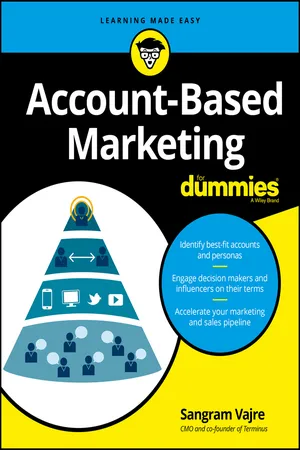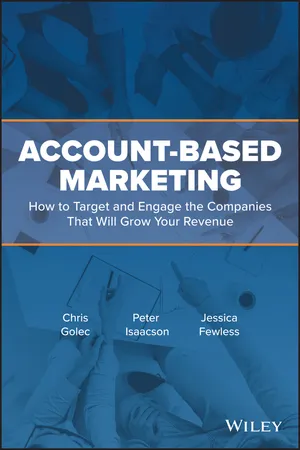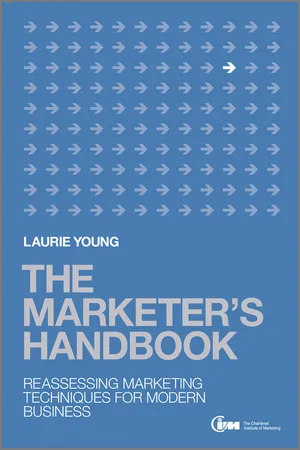Marketing
ABM Marketing
ABM (Account-Based Marketing) is a strategic approach that targets specific high-value accounts with personalized marketing efforts. It involves aligning sales and marketing teams to create tailored campaigns that resonate with the unique needs and challenges of individual accounts. By focusing on a select group of accounts, ABM aims to drive higher engagement and conversion rates.
Written by Perlego with AI-assistance
Related key terms
1 of 5
7 Key excerpts on "ABM Marketing"
- eBook - ePub
- Malcolm McDonald, Beth Rogers(Authors)
- 2017(Publication Date)
- Kogan Page(Publisher)
This chapter cuts through the noise with a clear definition of ABM and detailed descriptions of the three specific approaches that companies are taking. Robust, shared definitions ensure that all players – sales, marketing, delivery and other stakeholders – are working from the same operating manual. This is the first step to success with ABM.Defining ABM
If you Google ‘account-based marketing’ you are bound to discover a variety of definitions, many confusing and contradictory. Each person or organization views ABM through its own lens – some with self-serving agendas to sell a particular technology platform or service. ITSMA has penned this definition – Account-Based Marketing: treating individual accounts as markets in their own right.There are four underlying principles of ABM:- Client-centricity and insight. With ABM, sales and marketing focus on solving the buyer’s problem, rather than promoting the solution they want to sell. This outside-in approach means understanding clients and their organizations in enough depth to create propositions that help them achieve their business objectives.
- Partnership between sales and marketing.
- eBook - PDF
Value-ology
Aligning sales and marketing to shape and deliver profitable customer value propositions
- Simon Kelly, Paul Johnston, Stacey Danheiser(Authors)
- 2017(Publication Date)
- Palgrave Macmillan(Publisher)
7 Developing Coherent Campaigns 139 Further Reading Parrish, M. (2014). Create marketing your customers can use. Forrester Research. Content Marketing Institute. (2016). B2B marketing: 2016 benchmarks, budgets, and trends—North America. Fournaise Group. (2012). Annual survey: Global marketing effectiveness program. London. 140 Value-ology 141 © The Author(s) 2017 S. Kelly et al., Value-ology, DOI 10.1007/978-3-319-45626-3_8 8 Driving Results Through Account-Based Marketing In this chapter we will look at: • Our definition of account-based marketing (ABM) related to the value stack • The benefits of ABM • How to choose the right accounts for an ABM programme • A five-step framework to build your ABM plan • Common pitfalls to avoid with ABM This short chapter helps explain an account-based approach to marketing and why it may be beneficial for your organisation to adopt such an approach. What Is Account-Based Marketing? Account-based marketing (ABM), which has been growing in popularity over the past few decades, has become a bit of a buzz phrase lately. As tech- nology continues to advance, the definition of ABM has taken on a much more narrow definition than the one we recognise and are advocating in this book. Marketers now have access to more real-time data about their custom- ers than ever before (while they browse the product section of your website, for example). This makes it possible to target buyers on their terms with highly personalised messages and content. Many ABM technology compa- nies stop there, defining ABM as simply the ability to advertise to individual buyers across a variety of platforms (web, social, mobile, etc.). Let’s call this view ‘ABM.net’. We argue that ABM is not just about the technology or the ability to personalise content and reach individual IP addresses—ABM demands that you understand and market to your customers in a way that is relevant and resonates with them. - eBook - ePub
Smarketing
How to Achieve Competitive Advantage through Blended Sales and Marketing
- Timothy Hughes, Adam Gray, Hugo Whicher, Tim Hughes(Authors)
- 2018(Publication Date)
- Kogan Page(Publisher)
ABM can be applied in many forms, not just in ‘big accounts’ but across the spectrum of from big to small, such as SMEs. It does require you as an organization to focus, which can for some organizations be scary as there can be a level of reassurance in throwing mud at the wall and hoping it will stick. The reassurance is in activity; if we are doing ‘something’ then that’s good, isn’t it? Given the choice between 200 leads that create nothing and one lead that converts to revenue, I would take the one lead every time.What is account-based marketing?
According to Kogan Page’s A Practitioner’s Guide to Account-Based Marketing (Burgess and Munn, 2017) ABM is defined as:Treating individual accounts as markets in their own right. Then to position your company and its services with the aim of acquiring a greater share of clients’ business and earning continued loyalty…According to research by Ascend2 in January 2018, the number one reason that people implemented ABM was to align sales and marketing initiatives, followed by attributing marketing efforts to revenue. In the same report, such a plan was 95 per cent successful, which isn’t a bad success rate.What can be achieved with ABM?
Most organizations look to ‘increase share of wallet’, that is enable the business to up-sell and cross-sell. It always being easier to sell to existing clients than to new ones.In the B2B world, companies often have multiple value positions to sell. Certainly in the SaaS world, solutions are sold on the basis of ‘land and expand’. This means sales teams sell a pilot or low-value system, often below the radar of IT departments or certain purchasing limits so that a solution is sold which then starts being proven to be a business benefit to that organization. Often this is a small point solution or solving a niche problem. The solution provided is run as a pilot; hopefully it will be a success, at which point you can expand.Building on the success of the project a supplier can start building relationships with other people and parts of the organization to work on the expansion. This certainly seems to work well, as referencing your own organization as an end user is often seen as an easy option. ‘They are already a supplier to us’ will save a lot of effort in dealing with procurement or legal. - eBook - ePub
- Sangram Vajre(Author)
- 2016(Publication Date)
- For Dummies(Publisher)
Part 1Getting Started with Account-Based Marketing
IN THIS PART … Understanding ABM and how it’s changing the status quo of B2B marketing and sales Flipping the traditional lead-based funnel on its head for an account-based approach Unifying marketing and sales for one “smarketing” team to drive more revenue Leveraging marketing technology (MarTech) to remove manual processesPassage contains an image Chapter 1
Introducing the Basics of Account-Based Marketing
IN THIS CHAPTER Applying the fundamentals of account-based marketing Dissecting traditional B2B marketing practices Getting away from leads and the traditional lead-based funnel Flipping the funnel for account-based marketingAccount-based marketing (ABM) is a hot topic. #ABM and #FlipMyFunnel are trending on Twitter. At business-to-business (B2B) marketing events, featured speakers illustrate the value of account-based marketing. If you’re unfamiliar with ABM, this chapter shows exactly what account-based marketing is, and how it can change the status quo of how your company measures its success metrics.This chapter defines account-based marketing, and shows why ABM is such a powerful movement in the B2B marketing industry. I list the major reasons why companies need to implement account-based marketing, and how you flip the traditional B2B sales and marketing funnel. Instead of collecting tons of leads at the top of the funnel, I describe how to quickly identify your best-fit customers, then convert these prospects into your accounts for targeted marketing.Defining Account-Based Marketing
The essential definition of account-based marketing is focused B2B marketing. The term account-based marketing isn’t new. Identifying and targeting key accounts has always been a best practice for B2B marketing and sales teams. What’s different today about account-based marketing is that improved technology gives marketing teams the tools for account-based marketing at scale - eBook - ePub
Account-Based Marketing
How to Target and Engage the Companies That Will Grow Your Revenue
- Chris Golec, Peter Isaacson, Jessica Fewless(Authors)
- 2019(Publication Date)
- Wiley(Publisher)
ABM gives your organization the confidence to convert from a quantity game to a quality one. Chasing fewer leads means more resources can be devoted to the best opportunities, thus leading to higher pipeline velocity and higher closed–won rates.- Marketing and Sales become aligned. ABM requires a shift in Marketing’s focus away from individuals and toward accounts, which is exactly how Sales looks at the world. The historical tensions that exist between the two units don’t all magically disappear, but they are substantially reduced. There is further good news: as your organization starts to reap the benefits of your ABM strategy, the Sales team will lean in more and more to collaborate with you and contribute to your success.
- Customers receive a better experience. Focusing on a limited number of target accounts means that you can deliver a much more personalized experience to those accounts. Instead of focusing solely on demand generation, Marketing will work hand in hand with Sales throughout the buyer’s journey to mirror their message to the entire stakeholder committee that’s researching your products online. This type of consistency will help speed up the sales process.
- Marketing becomes connected to revenue. A fundamental, universal need for business has always been to generate revenue because you can’t take leads to the bank. ABM resolves the disconnect through which Marketing could be rewarded for generating leads that did not ultimately generate revenue. By linking Marketing’s goals not only to accounts but to accounts that produce revenue, at last the organizational gears can mesh properly and work in the same direction.
One Size Never Fits All
There are as many flavors of ABM as there are companies using it, but even so, it’s possible to group the variations into three levels, as seen in Figure 2.1 .Figure 2.1The Three Main Types of ABMSource: ITSMA and ABM Leadership Alliance Account-Based Marketing Benchmarking Survey, July 2017.One-to-One ABM
We’ve discussed the one-to-one form of ABM, which has been practiced basically forever. When Peter was head of worldwide field marketing at Adobe, it was called “Target Account Marketing.” They worked with Sales and selected around 20 accounts. Then they painstakingly and laboriously created what were known as “account plans” that were five to 10 pages long. The effort was worth it because Sales absolutely loved the detail Marketing provided, including org charts, who the decision makers were, key selling propositions, and so forth. - eBook - ePub
A Practitioner's Guide to Account-Based Marketing
Accelerating Growth in Strategic Accounts
- Bev Burgess, Dave Munn(Authors)
- 2021(Publication Date)
- Kogan Page(Publisher)
Strategic ABM and ABM lite share their list of top five tactics, but in a different order of importance. In strategic ABM, account-specific content and thought leadership is ranked second, with executive-to-executive relationship programmes ranked third. Then comes paid social media and email marketing or e-newsletters. This last tactic comes second for ABM lite, after webinars and virtual events, reflecting the lower investment across a cluster of accounts. Programmatic ABM’s tactics are more similar to those used in segment- or market-based campaigns, as you would expect, with targeted digital advertising and retargeting and content syndication (rather than bespoke content) on the list.The tactics that work best in strategic ABM and ABM lite reflect the care and attention that is lavished on one account when you treat it as a market in its own right. The award-winning case study from Infosys demonstrates this through its approach, which the company calls ‘unmarketing’.CASE STUDY Account-based ‘unmarketing’ at InfosysAt Infosys, strategic accounts are important, as over 97 per cent of the business is repeat business and the top 10 per cent of accounts deliver up to 80 per cent of revenue. Seeing this, marketing leadership realized that field marketers needed to become true ‘business partners’ to both sales and customers to drive sustainable account growth, accelerate opportunities and cultivate customer relationships.In addition to this mandate, Infosys needed a more focused way to challenge stereotypes and shift its reputation in the mind of its top clients from being just a transactional partner to being an active partner.To achieve this vision, the Infosys business unit and marketing leadership collaborated to identify the top 24 accounts with ongoing large deals that had both the potential to grow in revenue and the opportunity to deepen customer relationships. The way forward was showcasing the ‘new’ Infosys to these clients to potentially make them Infosys advocates and ideally leading to more business opportunities. - eBook - ePub
The Marketer's Handbook
Reassessing Marketing Techniques for Modern Business
- Laurie Young(Author)
- 2011(Publication Date)
- Wiley(Publisher)
So, account or relationship management as a discipline has its flaws. Account managers might, for instance, hoard information about their customers or miss more general trends because they are so focused on sales deals in one business. In fact, many companies have found that account management needs to be supported by service and marketing strategies to major customers. Leading firms in a range of international industries no longer see this as just a sales strategy or a marketing programme. They are creating products or services, value propositions, marketing strategies and communications programmes for one major customer at a time. This approach seems to have evolved more forcibly in the past decade because company after company has realized that some of their customers have revenues that exceed the GDP of some nation states. Logic suggests that if they were entering a new national market they would resource it with an experienced general manager and a range of operational capabilities. It would be much more than just a sales emphasis and so their most important customers should have more significant resources than just account sales teams. Some companies in business-to-business markets have called this “Account based marketing” (ABM) but it remains to be seen as to whether this becomes a generally recognized term.Voices and Further Reading- “Client-centric marketing is about managing client perceptions of your services and capabilities … to move client perception in a positive direction over the long term. The perception should be able to endure beyond changes in client personnel and changes in the company. Generalist approaches are no longer enough in today’s competitive market. No more going to big industry shows and trying to get clients to attend. This time, you customise the show, the roundtable and the thought leadership. You still have to do the big shows to create the awareness, but it’s no longer the basis of business to business services marketing – client or account centric marketing will be the model of the future.” Dr Charles Doyle, who initiated the original adoption of this technique at Accenture.
- Cheverton, P., Key Account Management . Kogan Page, 1999.
- Woodburn, D. and McDonald. M.H.B., Key Account Management: The Definitive Guide.
Index pages curate the most relevant extracts from our library of academic textbooks. They’ve been created using an in-house natural language model (NLM), each adding context and meaning to key research topics.
